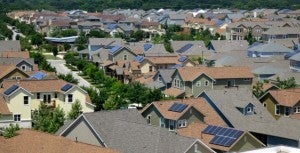Lowering The Price Of Residential Solar Starts In The Neighborhood
By: Guest Blogger Scott A Robinson, University of Texas at Austin – Energy Systems Transformation Group

The price of solar panels has been decreasing rapidly in recent years. This decrease in price has been reflected in residential markets, with installation numbers booming. However, the total costs of the system remain high enough to discourage mainstream adoption of the technology—even in places like Texas, which have abundant solar resources.
From a customer’s viewpoint, there are two components of the cost of a solar photovoltaics (PV) system. The first is the “sticker price” of the system: the price you pay out of pocket. The second is information cost: the time you must spend researching the technology to understand if it would be a good investment overall. This is a more difficult task for PV technology than it is for a new phone, or even a new car. The complexity of assessing solar PV creates a cost barrier on top of the reported price of the system.
To better understand these costs to consumers, and what can be done to decrease them, Dr. Varun Rai and I looked at data from PV owners across the state of Texas. We wanted to better understand the drivers behind the length of time people spent researching solar PV before deciding to buy. Our paper describing the results of the research, “Effective Information Channels for Reducing Costs of Environmentally-friendly Technologies: Evidence from Residential PV Markets”, was published last month in Environmental Research Letters (ERL).
We found that while information on solar PV is widely available, it is not easy to boil it all down to implications at the individual level because costs accrue as consumers seek to apply this information to their specific circumstances. On average, consumers spend around nine months considering their potential solar PV investment.
However, this is not the same for everyone. For example, the presence of other solar PV systems in the neighborhood was shown to increase confidence in the technology and motivation to buy—which decreased decision times. Furthermore, people who could talk with neighbors who had already purchased a solar PV system made even quicker decisions. In other words, when a potential buyer can see systems nearby, and access the knowledge of other owners, the decision to buy a system becomes easier and easier. Taken together, these information channels can decrease the decision period by an average of six months.
This means that neighborhoods with existing solar PV systems gain new systems quicker, making the decision easier for their neighbors. This positive feedback is the result of trustworthy information about a proven technology, and is driven by another finding: On the whole, solar PV consumers are highly satisfied with their purchase and eager to spread the word.











One Comment
This article hits the nail on the head! The solar industry has a problem in that information is not readily available to consumers in a way that makes it easy to shop for your Solar PV system. This is exactly what EnergySage aims to fix. At EnergySage we have created an online marketplace where consumers can get multiple quotes from installers for free. In addition, we make an effort to educate consumers, and help them through the process of buying. Eventually our case studies and reviews section will be robust enough that you can get the feeling that you are talking to a neighbor just by reading solar reviews on our website. For those interested in seeing the case study we are currently featuring, click here: http://bit.ly/16OHUSg